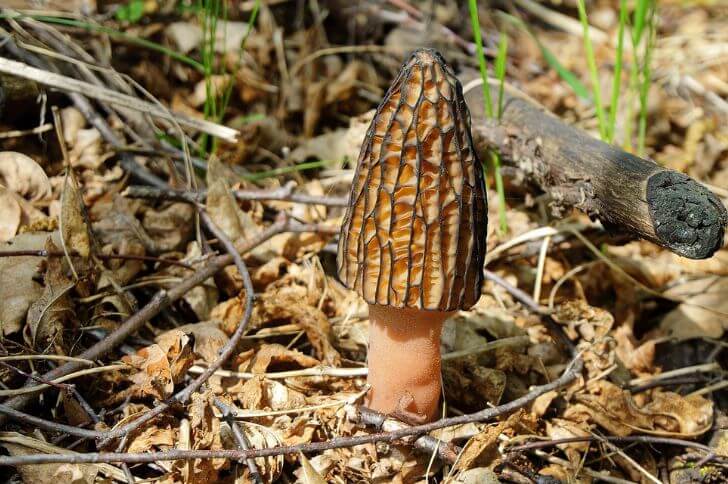In the enchanted world of fungi, where whimsical shapes and vibrant colors abound, one particular group never fails to captivate with its elegant allure: funnel-shaped mushrooms.
These fungi possess a distinct charm that sets them apart from their more conventional counterparts. With their striking funnel-shaped caps and slender stalks that delicately taper towards the ground, these mushrooms beckon explorers to delve into the depths of their mysteries.
From common chanterelles to the giant leucopax, we explore different types of mushrooms with this unique shape.
List of Funnel Shaped Mushrooms
1. Chanterelles
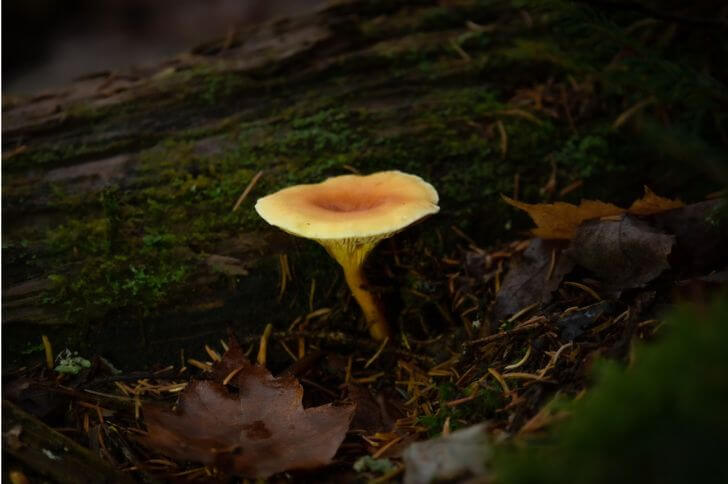
Chanterelles are a type of fungus known for their distinctive funnel shape and vibrant orange-yellow color. These mushrooms can be found in forests around the world, particularly in North America.
With their meaty texture and delicate flavor, chanterelles have become highly sought after by foragers.
One of the reasons why chanterelles are so popular is because of their versatility in cooking. They can be sautéed, roasted, or even used as a topping for pizzas and pasta dishes.
Their unique flavor is often described as nutty or earthy, with hints of apricot or peach. This makes them a perfect addition to both savory and sweet dishes.
2. Common Funnel (Clitocybe maxima)

Clitocybe maxima, also called common funnel, is a species that belongs to the family Tricholomataceae. This edible mushroom can be found in woodland areas across North America and Europe.
As its name suggests, the common is notable for its funnel cap that reaches up to 3.5 inches in diameter.
The distinctive funnel-shaped cap has a smooth texture and varies in color from pale cream to light brown. Underneath the cap, you will find closely spaced gills that are white or cream-colored.
While this funnel-shaped mushroom is considered edible, it must be cooked thoroughly before consumption.
3. Black Trumpet Mushrooms
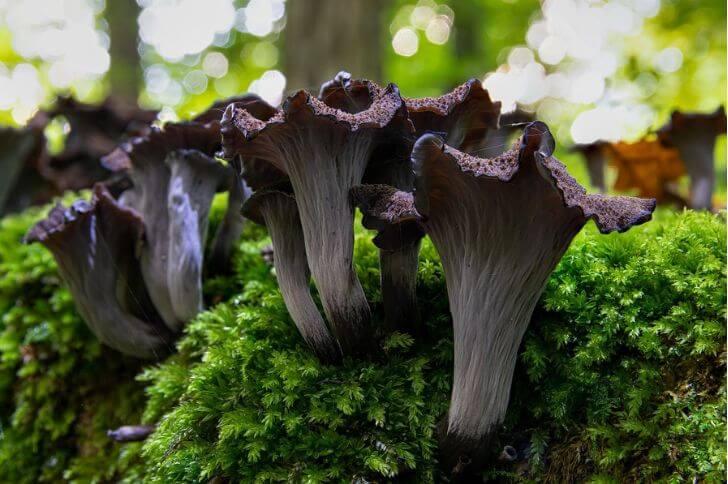
Black trumpet mushrooms, also known as Craterellus cornucopioides, are a species of funnel-shaped fungi that are native to North America, East Asia and Europe.
These unique mushrooms are highly prized for their deep, smoky flavor and meaty texture.
One distinguishing feature of black trumpet mushrooms is their dark coloration, which ranges from dark brown to almost black. They have a funnel-shaped cap with deeply ridged edges that give them an almost trumpet-like appearance.
Unlike many other mushroom varieties, black trumpets do not have gills underneath the cap but instead possess a smooth or slightly wrinkled surface.
4. Lobster Mushrooms
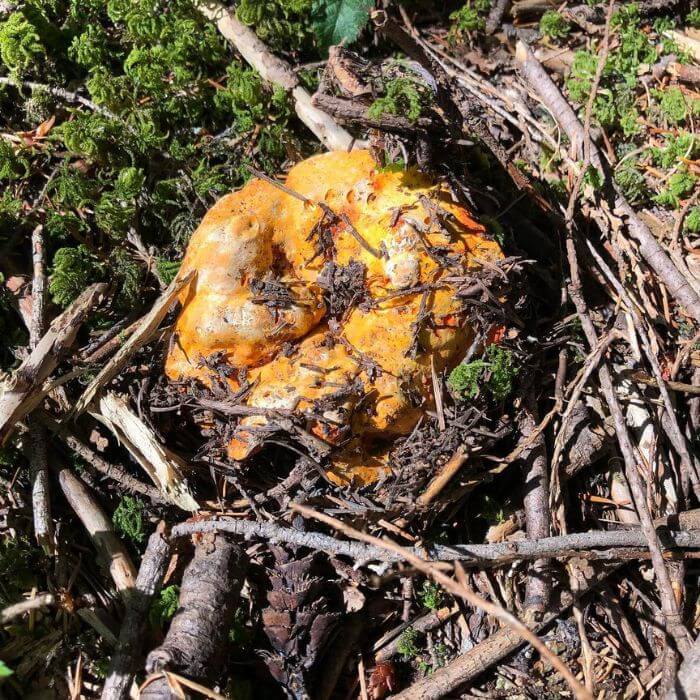
source: mywildgardendream
Lobster mushrooms are a unique and visually striking variety of fungi that belong to the funnel-shaped mushroom family.
Known for their vibrant, reddish-orange color and distinct appearance, these mushrooms taste like cooked lobster meat, hence their name. They can be found growing in North America and some parts of Asia.
What sets lobster mushrooms apart from other fungi is their unusual way of forming. They are actually not a true species but rather a parasitic fungus that takes over the host mushroom’s body.
The lobster mushroom infects various species such as Russula or Lactarius, completely transforming them both in appearance and taste. This transformative process occurs when the parasite invades the host’s mycelium network and replaces it with its own tissue.
5. Indigo Milk Cap (Lactarius indigo)
The Indigo Milk Cap is a blue funnel-shaped mushroom that belongs to the family Russulaceae. With its vibrant blue coloration and distinct features, this mushroom stands out among others in the forest.
One of the most striking characteristics is its deep blue cap. The cap measures around 2-6 inches in diameter and has a funnel-like shape with a depressed center.
Its surface is smooth and slightly sticky when wet. As it matures, the cap’s color may fade to pale blue or greenish-blue.
Beneath the cap, this blue fungus exhibits gills that are initially dark blue but turn paler as they age. When these gills are damaged or cut, they release a milky latex that gives this species its common name – Indigo milk cap.
6. Jack-o’-lantern Mushroom
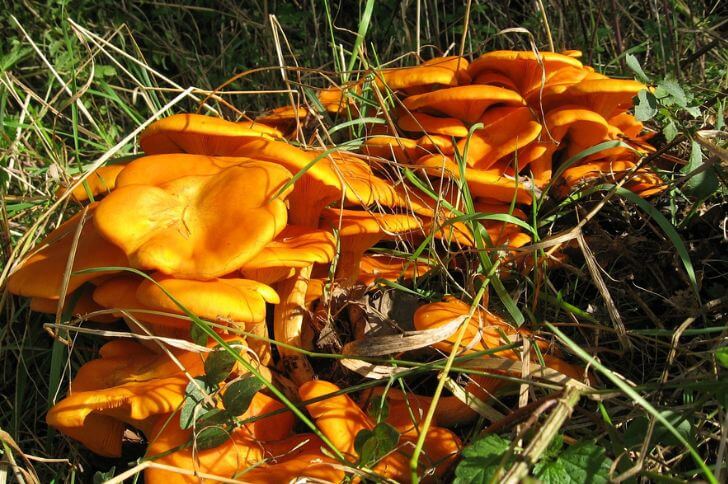
Jack-o’-lantern mushrooms are a fascinating group of fungi that are renowned for their unique ability to emit a faint glow in the dark, resembling flickering lanterns.
This phenomenon is caused by bioluminescence, which occurs due to the presence of a pigment called luciferin and an enzyme called luciferase within the mushrooms’ cells.
The jack-o’-lantern mushroom typically grows on decaying wood or stumps, often appearing in clusters during the summer-fall season. Its cap ranges in color from vibrant orange to yellowish-orange, and it has distinctive gills that run down its stalk.
While visually appealing, it’s important to note that jack-o’-lantern mushroom is inedible.
7. Bay Polypore (Polyporus durus)
A member of the polyporaceae family, the bay polypore is a large, brown funnel-shaped mushroom that ranges from Alaska to Mexico.
It can be found growing on decaying logs and stumps of hardwood trees such as oak, maple, and beech. The fruiting bodies of the bay polpore are characterized by their distinct funnel shape with a smooth, brown surface.
The cap grows to 7.8 inches wide and develops a wavy margin as it matures.
Another notable feature is its tough and corky texture. Unlike some other mushrooms that have soft flesh, this species has a woody consistency that allows it to withstand harsh weather conditions and remain intact for extended periods.
And like most shelf fungus, the bay polypore is inedible.
Related Read: Wood ear mushroom look alikes
8. Turbinellus kauffmanii

source: thank_you_chloe
Common in North America, the turbinellus kauffmanii belongs to the family Gomphaceae. Found primarily in Northern California, these mushrooms are known for their striking appearance and unique features.
The cap is vase shaped with a notable central depression. It measures about 7.5 inches in maturity.
Its surface texture is light brown and scaly, reminiscent of dryad’s saddle mushroom. Another distinctive characteristic is its stem, which is typically stout and solid, ranging in height from 2 to 4.7 inches.
9. Golden Oyster (Pleurotus citrinopileatus)

Golden Oyster mushrooms are an interesting species of funnel-shaped mushrooms. These mushrooms have a vibrant golden-yellow color that distinguishes them from other oyster mushroom varieties.
They are highly sought after not only for their aesthetic appeal but also for their culinary qualities.
Golden Oyster mushrooms have a delicate and mild flavor profile. They are incredibly versatile in the kitchen and can be used in various dishes such as stir-fries, soups, pasta dishes, and even grilled or sautéed as a standalone side dish. Their texture is firm yet tender, making them an excellent meat substitute for vegetarian or vegan recipes.
10. Giant Leucopax (Leucopaxillus giganteus)
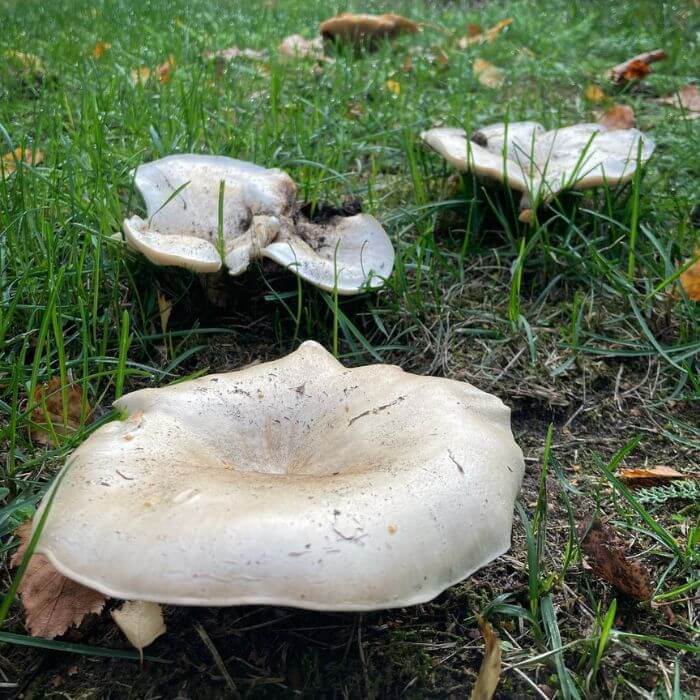
source: erajonnnan_sienet
The leucopaxillus giganteus is one of the largest vase shaped mushrooms in North America. This mushroom variety can grow to be quite large, with caps reaching diameters of up to 20 inches and heights of around 3.9 inches.
Its cap coloration typically ranges from pale white to cream or light brown, while the stem tends to be thick and sturdy.
One interesting characteristic of the giant funnel mushroom is its ability to form symbiotic relationships with certain tree species. It forms mycorrhizal associations primarily with coniferous trees such as pines and spruces.
Through this mutually beneficial relationship, the fungus aids in nutrient uptake for the trees while receiving carbohydrates in return.
Giant leucopax are edible but poor in flavor.
11. Fool’s Funnel (Clitocybe rivulosa)

source: frazerdjones
Another funnel-shaped mushroom you should know is the fool’s funnel or false champignon. belongs to the family Tricholomataceae.
With its distinctive funnel shape, this mushroom can be found in various habitats including deciduous forests and grasslands. The cap of the fool’s funnel is whitish and measures around 1.1-1.4 inches in diameter.
It has a smooth surface with wavy edges and may develop cracks as it matures. While visually appealing, it’s important to note that the fool’s funnel is inedible.
12. Zoned Tooth Fungus (Hydnellum Concrescens)

source: gabriele.bertolini90
Common under oaks in parts of Eastern North America, the zoned tooth fungus have a distinctive look that make them easily identifiable.
This mushroom starts out with a flat cap that gradually turns inward to form a vase shape. Zoned tooth cap ranges from pale pink whitish to pinkish brown, while the underside is covered with tiny spines that are white or cream-colored. This combination of colored zones makes it unique, hence its common nickname.
These mushrooms are typically found in coniferous forests, where they have a symbiotic relationship with the trees they grow near. They form mycorrhizal associations with tree roots, helping them absorb nutrients while receiving carbohydrates in return.
13. Tawny Funnel Cap (Paralepista flaccida)
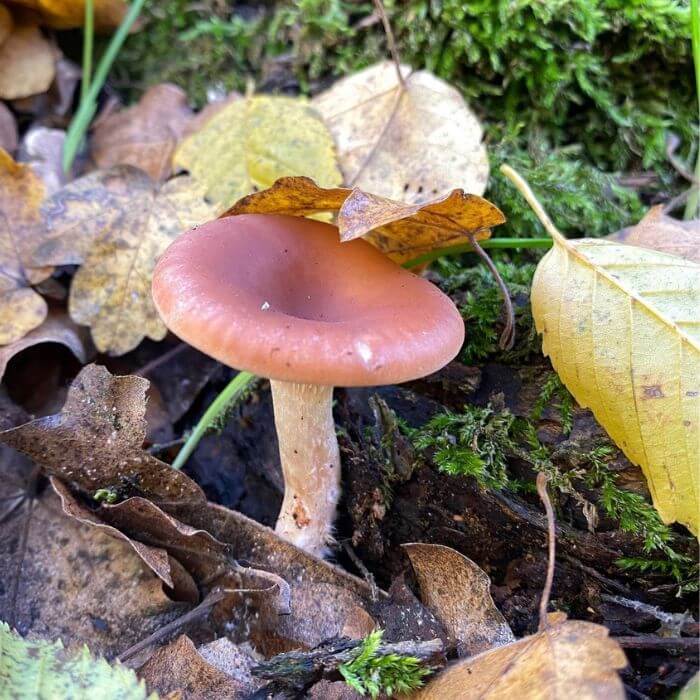
source: quuxuum89yang
Another member of the family Tricholomataceae, the tawny funnel caps are characterized by their distinct funnel or trumpet shaped fruiting bodies.
They typically have a smooth cap that ranges in color from orange to brown and can grow up to 3.9 inches in diameter.
Underneath, these vase-shaped mushrooms have gills that are attached directly to the stem. These gills are closely spaced and can be white or pale brown when young but gradually turn darker as the mushroom matures.
The stem itself is slender and often curved, with a whitish color that may develop patches of reddish-brown towards the base.
14. Goblet Mushroom (Pseudoclitocybe cyathiformis)
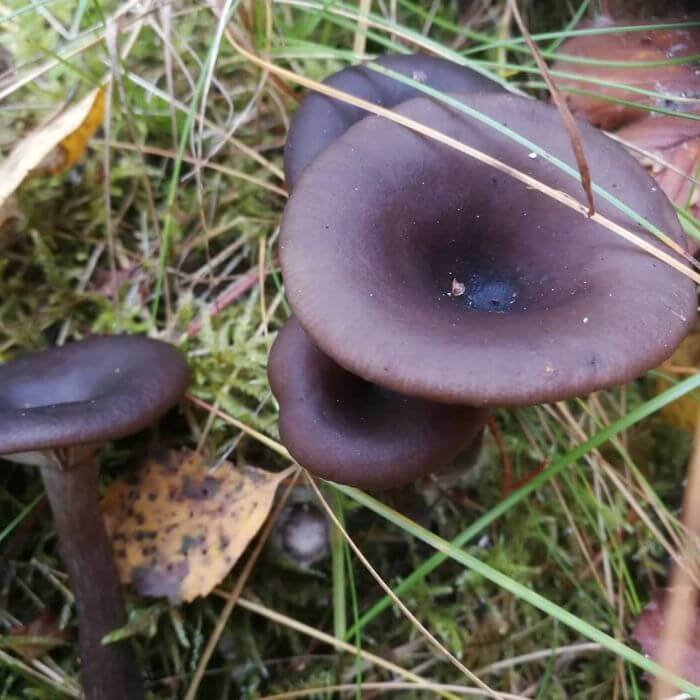
source:nature_lover_from_finland
With tall scaly stalks and dark caps, goblet mushrooms are easy to identify. This fungus is characterized by its funnel-shaped cap, which typically measures between 1.5-3.1 inches in diameter.
The cap’s color can vary from pale gray to brownish-gray with noticeable inrolled margins.
Underneath, young goblet mushrooms have forked whitish gills that turn beige or gray in maturity. Its stem is relatively long and slender, measuring around 4 inches in height. Stem has no ring.
These funnel-shaped mushrooms are edible and should be well cooked before consumption.
15. Tuberous Polypore (Polyporus Tuberaster)
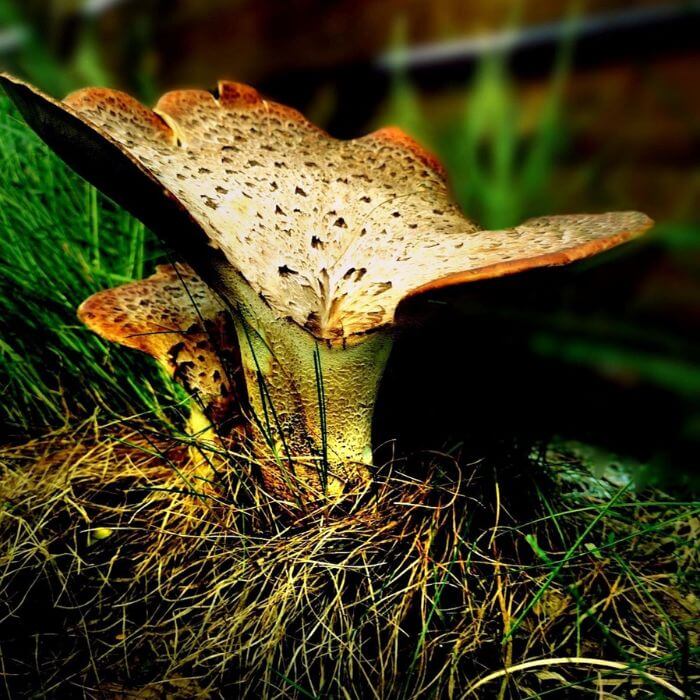
Tuberous polypore is an uncommon deeply funneled fungus that belongs to the Polyporaceae family. This funnel-shaped mushroom has a distinct appearance with a light brown to orange brown fruiting body with slightly inturned margin.
Is the tuberous polypore edible? Yes, you can eat this polypore when young. It has a mild taste.
Final Thoughts:
There are several types of funnel-shaped mushrooms that can be found in various habitats around the world. These mushrooms are characterized by their distinct funnel or trumpet shape, and they come in a range of colors and sizes.
Some of the most common species include the chanterelle, the black trumpet, and the yellowfoot. Funnel-shaped mushrooms are not only visually appealing but also have unique flavors and textures that make them popular among mushroom enthusiasts.
Whether you are a beginner or an experienced forager, exploring the different types of these mushrooms can be a fascinating and rewarding experience. So go out and start your mushroom hunting adventure today!
source:
Hi There,
My name is Jenny. I’m the Chief Editor at Try Green Recipes and besides making yummy and healthy foods for my kids, grandkids, and friends. I’m new to the blogging world but I believe what I have to share is unique and will bring joy to your home. If you are adventurous and want try something tasty, let’s get started.

